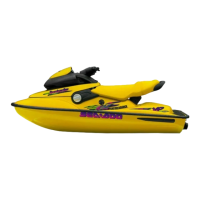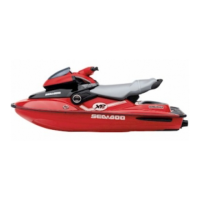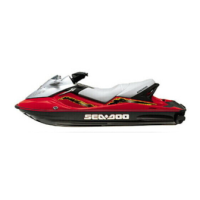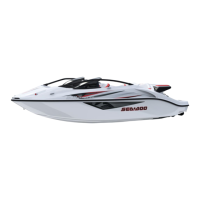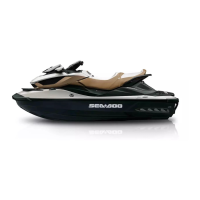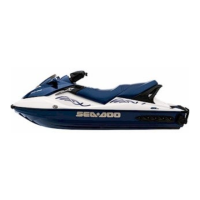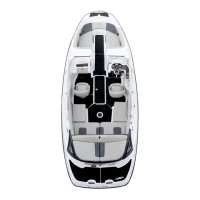Why Sea-doo Boat has weak spark?
- SStacy HernandezSep 8, 2025
If the Sea-doo Boat has a weak spark, it could be due to fouled, defective, or worn spark plugs, or too much oil supplied to the engine. Replace the spark plugs.
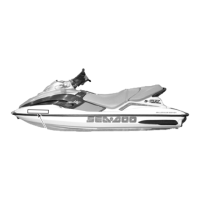
Why Sea-doo Boat has weak spark?
If the Sea-doo Boat has a weak spark, it could be due to fouled, defective, or worn spark plugs, or too much oil supplied to the engine. Replace the spark plugs.
Why Sea-doo Boat beeps 1 long beep?
The Sea-doo Boat beeps once for a long time because the safety lanyard has been on the post for more than 10 minutes without starting the engine, there's a bad connection, the wrong safety lanyard is being used, the safety lanyard is defective, dried salt water is in the safety lanyard cap, or there's an improper operation of MPEM or a defective wiring harness. Apply slight pressure or remove and reinstall the safety lanyard. Reinstall the safety lanyard cap correctly over the post. Use a safety lanyard programmed for the watercraft. Clean the safety lanyard cap to remove salt water.
| Model Year | 2001 |
|---|---|
| Type | Personal Watercraft |
| Manufacturer | Sea-Doo |
| Model | GS |
| Displacement | 718 cc |
| Horsepower | 85 hp |
| Fuel System | Carbureted |
| Seating Capacity | 2 |
| Length | 106 in (269 cm) |
Fundamental rules and precautions for all watercraft operators.
Guidelines for safe riding, including PFD use, protective clothing, and handling.
Explains the location and composition of the Hull Identification Number.
Details the location of the Engine Identification Number for various engine types.
Visual map of controls and components specific to GS model watercraft.
Visual map of controls and components specific to XP model watercraft.
Visual map of controls and components specific to GTS/GTI model watercraft.
Visual map of controls and components specific to RX Series watercraft.
Visual map of controls and components specific to GTX Series watercraft.
Explains the safety lanyard function and the Digitally Encoded Security System.
How the handlebar controls the watercraft's direction and steering.
Operation of the throttle lever for acceleration and engine start/stop button.
How to use the VTS button and gauge to adjust ride characteristics.
Guide to using the LCD information center for displays, messages, and settings.
Proper operation of the fuel tank valve and access to the fuel tank cap.
Specifications for the correct fuel and oil to use for optimal engine performance.
How to maintain the oil injection system and ensure proper lubrication.
Recommendation for a dealer inspection after the first 10 hours of operation.
Explanation of how the jet pump system propels the watercraft.
How to use the shift lever to select forward, neutral, or reverse.
How to adjust the VTS for optimal performance and handling in different conditions.
Guidance on effective steering and turning methods for control and safety.
Step-by-step instructions for safely boarding the watercraft from docks or water.
Detailed steps for starting the engine, including preparation and warm-up procedures.
Procedures for slowing down, docking, and approaching the shore safely.
Routine cleaning and specific care needed after operating in foul or saltwater.
Procedures for flushing the cooling system and lubricating the engine internals.
Techniques to protect metallic components from corrosion, especially after saltwater use.
Understanding system warnings and the watercraft's reduced performance mode.
Steps to address engine overheating and clear obstructions from the jet pump intake.
Procedures for righting a capsized or recovering a submerged watercraft.
Steps to resolve issues with engines affected by excessive water or fuel.
Guidelines for towing the watercraft safely and addressing low battery issues.
Overview of responsibilities related to engine emissions standards and regulations.
Specific points for lubrication and the recommended procedures and lubricants.
A comprehensive chart detailing inspection items, frequency, and responsible party.
Importance of carburetor adjustment and inspection of fuel injection systems and filters.
How to check and replace fuses to resolve electrical problems.
Routine checks of the engine compartment, electrical connections, hull, and cleaning advice.
Regulations and precautions for towing the watercraft securely and legally.
Recommendations for proper storage, including draining the engine and fuel systems.
Detailed steps for installing antifreeze to protect the cooling system during cold weather.
Guide to interpreting audible signals from the monitoring system to identify problems.
Solutions for problems like engine not starting, running rough, or lacking power.
Diagnosing and fixing issues such as misfires, overheating, and speed limitations.
